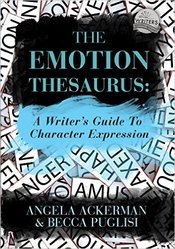Author Tips: Show, Don't Tell - Using The Emotion Thesaurus
 In my quest to grow as an author, I'm constantly finding new things that help me better my craft. Sometimes they are fantastic articles online and other times they are suggestions from author friends who have been at this longer than I have.
In my quest to grow as an author, I'm constantly finding new things that help me better my craft. Sometimes they are fantastic articles online and other times they are suggestions from author friends who have been at this longer than I have.One of the biggest challenges a lot of authors face is the ability to accurately portray their character's thoughts and emotions to the readers. This is an area of writing that I continue to strive to improve in.
It's easy enough to use words to tell our readers what a character is doing or saying. But if we can show how a character is reacting to an emotion, the words we use become much more powerful.
Let's take a look at some examples. Here's a case of telling the reader what the character is going through:
Sally walked back and forth across her studio, her heart beating wildly with fear. What if the intruder found out where she was? There was a sound on the other side of the door and she jumped. Was it him? She prayed the lock would hold until help arrived.
Sure, we know what's going on with Sally and we know that she's scared. Who wouldn't be in a situation like this?
But as writers, we can do so much better. We can wield words to help the reader feel what the character is experiencing:
Sally paced the floor of her studio, her legs weak. She shook her hands out as her heart galloped in her chest and the sound of blood rushing through her body filled her ears. She gulped back a breath as her eyes flitted from the window to the secured door. A scratching on the other side made her jump. Sally's mouth went dry and she tried to swallow past the lump that formed in her throat. What if the intruder was outside? She prayed the lock would hold until help arrived.
Which paragraph paints a better picture? I would much rather experience a situation with the character than be told how I should react.
 As an author, showing instead of telling isn't always easy. I'm definitely getting better with practice. I've also found that there are some amazing tools out there that have made a difference in my writing.
As an author, showing instead of telling isn't always easy. I'm definitely getting better with practice. I've also found that there are some amazing tools out there that have made a difference in my writing.One of those is the book The Emotion Thesaurus: A Writer's Guide to Character Expression by Angela Ackerman and Becca Puglisi. If you haven't taken a look at this book before, I strongly urge you to do so.
Inside, you'll find a number of emotions listed from Anguish to Dread, from Gratitude to Love. With each emotion, the authors give a definition followed by very specific information that can be crucial to helping you describe a situation that your character is facing:
Physical signals
Internal sensations
Mental responses
Cues of acute or long-term responses to the emotion
What the emotion might escalate to (a stronger emotion)
Cues of a suppressed emotion
A writer's tip at the end
I keep this book on my desk and I pull it out numerous times per writing session. I can't recommend it enough. I usually buy my books in digital format. My wonderful husband bought this one for me in paperback and I'm incredibly glad that he did. There's something about being able to reach for it and flip right to the emotion I need in seconds.
If you struggle with showing rather than telling in your writing, maybe a book like this could be of use to you as well. If you're an author who has a good grasp of this skill, the book can still be a wonderful source of different responses you can have your character experience.
Either way, The Emotion Thesaurus is a reference I think all writers can benefit from.
What kinds of references do you find helpful during the writing process? I'd enjoy hearing from you!
Published on July 19, 2015 16:48
No comments have been added yet.



